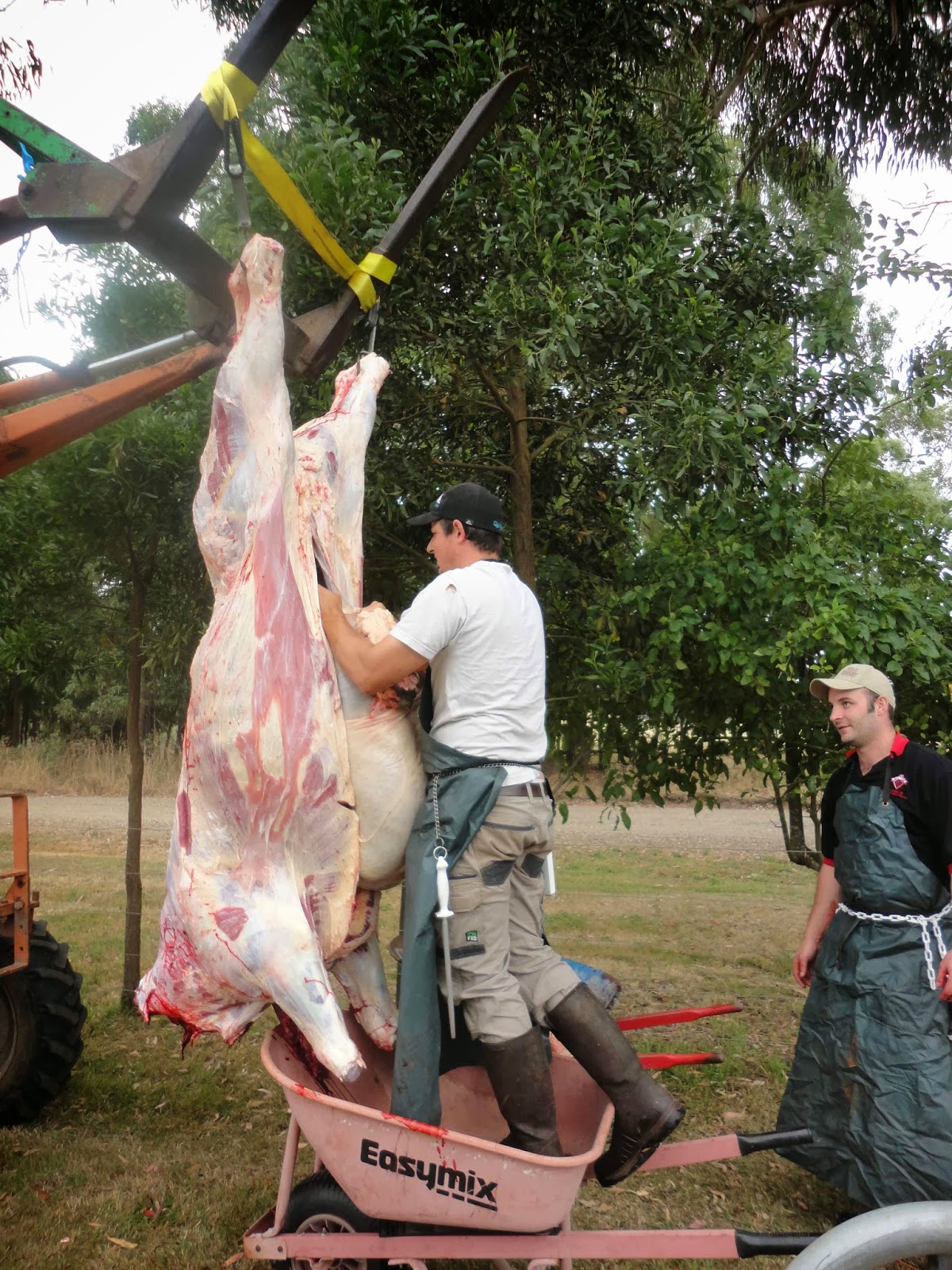A newly born calf... Sunday. What a wild ride he gave us. He was a 'forceps' baby. His first few weeks were tenuous as he grappled with the cold winter rain and winds. His first time mum, Thursday, did her best. She soon got the hang of being a mum.
And then in a blink of an eye, it's a year and 4 months since the day Sunday was born. At this age, the meat on a steer is good. So with a deep breath, Frans called the slaughter man and made a date.
On the morning of the home kill, Frans moved all the cattle through the yard and separated Sunday from the rest. He was calm and not distressed at all. The key is to keep any stress from the animal as this translates into tough meat. Our butcher is careful, clean and has an attitude towards the animals that he has to slaughter that is commendable. He's not hurried. He takes his time to keep the beast calm. When the moment of death comes, it's quick and deliberate. I still find the transformation from 'farm animal that I love' to 'meat' amazing. One moment the beast standing in front of you is one you have a connection with, and the next you're observing the carcass and all connection has been severed. I have to remind myself that the reason we're doing this is so we have control of our food chain. We know exactly what our animals are feeding on, how they're being treated and how they're being processed. Although the process of killing one of your own animals brings a tear to your eye, (yes it did!), we're pleased that we can be a part of the cycle that provides us with our food, and with it, we are able to respect the animals that allow us this privilege.
The tools of the trade. A bucket full of essentials... Knives, ropes and sharpening steels. The metal frame is used to balance the carcass while the skinning gets done.
Heavy machinery is required too! The beast weighs around 450kgs. Too heavy to manoeuvre easily. Frans borrowed our neighbour's tractor to help with the lifting.
The beast is moved away from the cattle yard and into our paddock for the slaughtering.
Once moved by tractor, the skinning begins. Our butcher and his off sider work quickly and efficiently.
These fellas are well practised. They know what they're doing.
As the skin gets cut away, it's time to lift the carcass up.
Back breaking work!
The first delicacy that is handed over after the kill is the ox tail. I'm planning a feast of Ox Tail and Dumplings. Just like my Mum used to make! The second delicacy was the cheeks. I've been trawling the Internet for the best recipes. Long, slow cooking is required for this rare treat.
Not long and the skin is off. Next it's the cutting away of the guts and the rest of the smelly bits. A wheelbarrow is a handy tool. It's not only useful for gardening!
A clean cut is what is required. We don't want any piercings of any tubes or other bits!
Mission accomplished. The guts are removed neatly and cleanly.
When calculating the size of the beast, it's generally worked out on 'dressed weight'. This means that the skin, head, feet and guts are removed. What's left is the useable part of the beast.
We are left with a cleaned animal. Next is the quartering.
The carcass is cut into four big hunks.
It's a lovely cool day. No flies about. This is good!
When we slaughtered our first beast a year ago, we hung it for 5 days. This time, we're going to hang it for 21 days. The idea is that the meat will become more tender as the muscle fibres break down. The cool room is supplied by our butcher. The challenge is to keep the temperature between 2 and 4 degrees on the hot days when we've had 43 degrees!
Hefting the beef into the cooler is heavy work!
Four quarters.... these will feed us for a good part of a year.
And there you have it... Approximately 250kgs of beef. We'll get steaks, osso bucco, mince, sausages and roasts.
Stay tuned for part 2. The cutting up!
Wayward calves......
In the heat we've turned off our electric fences to prevent any sparks or fires. Of course this is just an invitation to our young calves to go wandering! Barbed wire makes no difference. Here's our youngest, Misty, breaking back trough the fence!
Frans and I headed down to our furtherest fence line to repair the break. First he did some weeding! Gorse and Scottish Thistle had to be removed.
Walking around the paddock is hazardous. The pug holes from the cattle are big and deep. Twisting an ankle is easy!
Fencing fixed.
One day last week, when it was cooler, I toddled off to Port Campbell with Granny Pat. We had lunch near the water. What a view!
We took a slow drive home via the Great Ocean Rd, and stopped to say 'hello' to one of the Apostles.
Till next time... have a cool week. Drink plenty of fluids!






























No comments:
Post a Comment